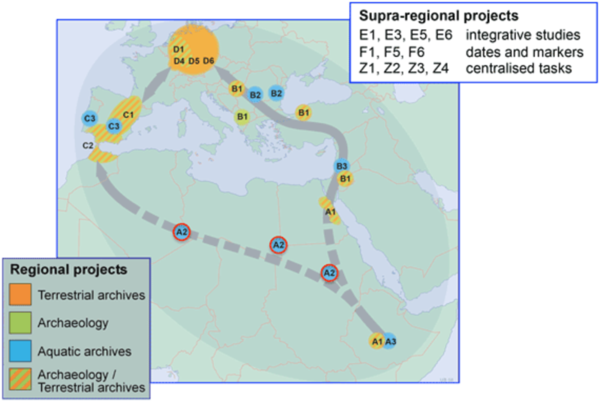CRC 806 – Our Way to Europe: climatic and environmental changes in the upper Pleistocene - middle Holocene of the Iberian Peninsula (project C3)
Summary
Project C3 was newly established for the second phase of the CRC 806 (2013 - 2017). It focuses on the reconstruction of the late Pleistocene to middle Holocene climatic and environmental history on the Iberian Peninsula (IP), based on the investigation of long and preferably continuous records of lake and lagoonal sediments. During the first CRC phase, these geoscientific investigations were partly carried out in the framework of the C1 project, however, it turned out that the number of potential sites is larger than originally expected and the workload for high-resolution multi-proxy analyses is so high that it justifies a stand-alone project C3 in the Cluster C of the CRC.
Generally, cave and alluvial sediments are discontinuous archives, due to irregular sedimentation resulting in environmental changes and variable preservation conditions. Therefore, project C3 will focus on cores from mainly persistent sediment traps to cover the time intervals continuously, which are considered in projects C1 and C2 discontinuously. In southern Iberia, the record of continuous archives is rather rather poor, compared to Northern Iberia, since southern Spain and Portugal are no typical lake countries. However, we identified and tested several promising archives during the first CRC phase, broadly north of the 40th parallel. These records will fill a regional gap in Late Quaternary palaeoclimate archives that exists between marine records from the Atlantic off Portugal (ODP Leg 149; plus e.g. IMAGES core MD95-2042) and from the Sea of Alborán (Leg 161; plus e.g. IMAGES core MD95-2043) on the one hand, and terrestrial records on the IP, e.g. the Padul peat bog near Granada city, on the other hand. The distance between theses archives is up to 600 km, crossing the climatic zones of the humid Atlantic IP (Portugal and Galicia) and the dry Mediterranean IP (Extremadura and Andalusia).

Both, the Atlantic IP and the Mediterranean IP, were inhabited by Neanderthals and anatomically moderns humans and subjected to a direct climatic influence of the North Atlantic Oscillation (NAO), including short-term climate changes such as the Heinrich Events (HE) or the Dansgard/Oeschger Events (DO events). Our investigations of sedimentary archives on the western IP have a temporal focus on MIS 3 to MIS 2, or on the four main techno complexes Late Middle Palaeolithic to Early Upper Palaeolithic, Gravettian and Solutrean (in project C1), and Magdalenian (transition into MIS 1). Special emphasis is put on short-term HE and DO events, rapid environmental changes that may have forced reactions of hunter gatherer populations.
Some of the archives tested in the first CRC phase turned out to be not suitable for high-resolution studies. This includes the sediment record in the polje of Zafarraya, incised into Jurassic limestone, which was investigated by geophysical and geological surveys. More promising are archives such as the sediments in ephemeral lakes of the Triassic gypsum karst (Keuper facies). These partly saline or freshwater lakes – confusingly called ‘lagunas’ in Spanish – yield long sedimentary sequences, which are currently under investigation. Our envisaged sites are all geographically closely related to the cave and rock shelter sites investigated by project C1. They constitute small lakes or coastal lagoons (partly with a freshwater phase). In Portugal we also incorporate some caves, because stable isotope studies of speleothems are lacking and lake deposits are rare in this part of the IP.
Our laboratory work on the sediment sequences will comprise high-resolution sedimentological, geochemical, and geophysical analyses, including Multi-Sensor Core Logging (MSCL), X-Ray Fluorescence (XRF) scanning, and organic geochemistry. The age models will be based on radiocarbon, luminescence, and palaeomagnetic dating, carried out in close cooperation with CRC projects F1, F5, and F6, respectively. In addition, stable isotope studies of carbonates, both from speleothems and from lacustrine sediments, will be conducted in cooperation with project B5. The palaeoenvironmental results will be extensively compared with the cultural changes on the IP, detected by project C1 and with data on man-environment relationships from Morocco generated by project C2.